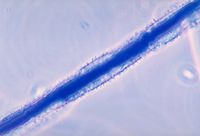Aspergillus flavus
For the course duration, the article is closed to outside editing. Of course you can always leave comments on the discussion page. The anticipated date of course completion is May 21, 2009. One month after that date at the latest, this notice shall be removed. Besides, many other Citizendium articles welcome your collaboration! |
| Aspergillus Flavus | ||||||||||||||
|---|---|---|---|---|---|---|---|---|---|---|---|---|---|---|
 | ||||||||||||||
| Scientific classification | ||||||||||||||
| ||||||||||||||
| Binomial name | ||||||||||||||
| Aspergillus flavus |
Description and significance
Aspergillus flavus is a filamentous fungus. It produces a mycotoxin called aflatoxin B that is carcinogenic.[1] It causes liver damage and is one of the mycotoxins used as a biologcal weapon[2]. When crops are infected with A. flavus their value decreases because of the potential human or animal exposure to the aflatoxin.[3] A. flavus is mainly a saprophyte, meaning it obtains its nutrients from dead or decaying material, but it can also be a pathogen to plants and animals including humans.[1]
Pathology
A. flavus is an opportunistic pathogen, which allows it to infect animals, humans and plants. It is not virulent in healthy viable tissues. A. flavus targets seeds with poor viability. It infects seeds by entering wounds and holes from which insect larval have exited, and by entering from the vascular tissue. A. flavus can infect plants via its seeds or by being carried to the surface of the plant by insects or wind. Also it can be colonized but not infected until the plant is matured. A. flavus infects cotton by entering from natural openings and traveling up into the boll. In the boll the fungus can be there for twenty five days, not infecting the boll until matures. In peanuts the fungus can infect seeds as well as the plant by penetrating the pods that peanuts grow in.[4]
In humans A. flavus is associated with aspergillosis, a secondary respiratory infection in immuno-compromised patients. In certain areas it is also the cause of infections. Cite error: Closing </ref> missing for <ref> tag A. flavus is also an allergen. It causes allergic bronchopulmonary aspergillosis. 5
Ecology
Aspergillus flavus can be found all over the world; however it is found to be abundant in places of warm temperature. Field contamination is mostly present in areas with high temperatures and drought. It is also abundant in areas with temperate climates during warm drought years. In the US it affects the corn crop in the south eastern area. 5
A. flavus grows in temperatures of 25-42˚C, but the optimal temperature for growth is 37˚C. It survives through winter as a mycelium or sclerotia. Sclerotia is a resistant structure that is developed into hyphae or conidia. The conidia are then scattered into air and soil by insects or wind.[1]
Cell structure and metabolism
A. flavus is also known as a mold. Like other molds it also grows by producing hyphae. The network of hyphae, or mycelium,are responsible for secreting enzymes. The enzymes secreted are used to break down complex food sources. The complex food sources are broken down into small molecules which are then absorbed by the myceilium, which uses the small molecules to grow. Mycelium contain conidia or asexual spores, both the mycelium and conidia can be seen with the naked eye while the hyphae cannot. Young conidia in A. flavus are yellow green and as the spores age they turn a darker green. A. flavus can use many nutrient sources but being a saphrophyte it uses primarily dead or decaying materials.[1] Being a saphrophyte is important for "A. flavus" life cylce because it allows the fungus to be present in dieing tissue of plants. These dieing tissues which are infected with "A. flavus" stay in the soil allowing the "A. flavus" to infect other plants. [5]
Genome structure
The genome of A. flavus strain NRRL 3357 has been sequenced. It has 2761 scaffolds and each scaffold has anywhere between 4.5 Mbp to 200 bp. It has approximately 13,487 genes and the average length of each gene is 1485 bp.[1]
Application to Biotechnology
The genome was sequenced at The Institute for Genomic Research in Maryland. It has also been entered into the BLAST database.[1]
Current Research
With the sequencing of the genome done, current research is focused on using the sequence to understand the fungus, to yield crops that are resistant to the fungus and to determine tools to control the production of the aflatoxin. One of the ways that the control of the production of aflatoxin is being researched is to see how the use of chemicals can weaken the oxidative stress response. ( oxidative stress has been shown to increase the production of aflatoxin.) There have been many unsuccessful experiments conducted on yielding A. flavus resistant crops of peanuts and corn. Currently research is being done to cultivate genes that are resistant to A. flavus, afflatoxin production and plant stress. These genes will then be used to create resistant crops. 5
References
- ↑ 1.0 1.1 1.2 1.3 1.4 1.5 Aspergillus flavus hosted by aspergillusflavus.org
- ↑ [Mold-Help.org. "Aspergillus."] hosted by Moled-help.org
- ↑ [Mellon J, Cotty P, Dowd M. Aspergillus flavus hydrolases: their roles in pathogenesis and substrate utilization. Applied Microbiology & Biotechnology [serial online]. December 2007;77(3):497-504. Available from: Academic Search Premier, Ipswich, MA. Accessed April 12, 2009]
- ↑ [KLICH M. Aspergillus flavus: the major producer of aflatoxin. Molecular Plant Pathology [serial online]. November 2007;8(6):713-722. Available from: Academic Search Premier, Ipswich, MA. Accessed April 15, 2009]
- ↑ [1] hosted by pathport.vbi.vt.edu
2. Mellon J, Cotty P, Dowd M. Aspergillus flavus hydrolases: their roles in pathogenesis and substrate utilization. Applied Microbiology & Biotechnology [serial online]. December 2007;77(3):497-504. Available from: Academic Search Premier, Ipswich, MA. Accessed April 12, 2009
4. Mold-Help.org. "Aspergillus." Accessed April 13, 2009
5.
6. Cleveland T., Yu J., Fedorova N., Bhatnagar D., Payne G., Nierman W., Bennett J. Potential of Aspergillus flavus genomics for applications in biotecnology. Trends in Biotechnology. Vol. 27 No. 3. February 3, 2009.